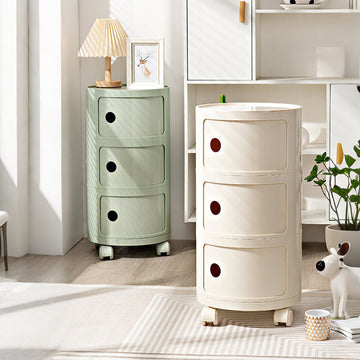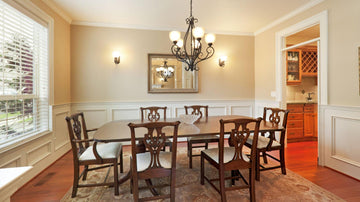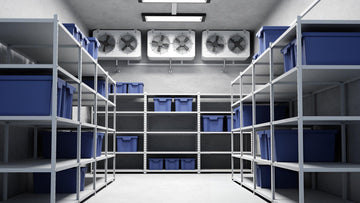Table of Contents
- How Tall Should a Nightstand Be?
- Why Nightstand Height Matters
- How to Measure Your Ideal Nightstand Height
- Nightstand Dimensions: Width, Depth & Placement Tips
- Nightstand Storage and Functionality Tips
- How to Choose a Nightstand That Fits Your Bedroom Style
- Nightstand Tips for Seniors, Kids, and Small Bedrooms
- Final Nightstand Buying & Customizing Tips
- Conclusion
How Tall Should a Nightstand Be?
Nightstands might not steal the spotlight in your bedroom, but they quietly do a lot of heavy lifting. Sitting right beside your bed, they keep your nighttime must-haves within arm's reach, add visual balance, and—believe it or not—can shape how smoothly your evenings and mornings go.
The problem? When the height is off, it just feels... wrong. If it's too tall, you're awkwardly reaching up. Too short, and you're constantly leaning. Not exactly the relaxing vibe you're going for.
So, how tall should a nightstand be? According to Susan Caudle at Hardwood Artisans, "The best nightstand is the one you can reach without straining—something that feels natural to use." And the right height? It's not universal. It comes down to your bed setup, your mattress, and your own comfort zone.
In this guide, we'll help you figure out your ideal nightstand height—starting with one quick measurement, a few practical pointers, and just a touch of design thinking. Whether you're furnishing a brand-new bedroom or finally replacing that too-tall table that's been bothering you, getting this one detail right can make your space feel more complete—and a lot more livable.
Why Nightstand Height Matters
It's easy to get pulled in by the look of a nightstand—how it matches your bed frame, whether the drawer handles are the right finish, or if it has enough space for your charger and a novel. But there's something less obvious that can affect your experience with it every single day: how tall it is.
You might not notice it right away. But after a few nights of awkwardly reaching up for your phone, or leaning lower than feels natural just to grab a glass of water, it starts to make an impression—in all the wrong ways. When you're tired, these small movements can become surprisingly annoying.
Then there's how it fits into the room visually. A nightstand that sits well above your mattress can feel oddly out of sync, like it's meant for a different setup entirely. One that's too low might look unfinished or slightly mismatched, even if everything else is styled just right.
Getting the height right doesn't just make the nightstand easier to use—it makes the entire area around your bed feel more intentional. And in a space meant for rest, that kind of quiet balance can go a long way.

How to Measure Your Ideal Nightstand Height
So, how tall should your nightstand be? The simplest answer: just about level with the top of your mattress. Some people search for ‘bedside table height,’ but it’s the same idea—the goal is comfort and reachability. But since beds vary a lot in height—especially with today's thicker mattresses and different frame styles—It’s worth measuring your bedside table height based on your actual bed setup—mattress thickness and frame style vary a lot.
Here's how to figure it out:
Step 1: Measure from the floor to the top of your mattress.
This number is your baseline. Most standard beds fall somewhere between 22 to 30 inches high. Platform beds tend to be on the lower end, while traditional box spring setups or beds with storage drawers underneath will sit higher.
Step 2: Match your nightstand to that height—or go slightly lower.
Ideally, your nightstand should be the same height as your mattress, or up to 1–2 inches below. Going lower makes it easier to reach for things like your phone or a glass of water without raising your arm too much. Avoid anything taller than your bed—it tends to feel awkward and can disrupt the visual line of your furniture.
Step 3: Consider how you use your nightstand.
If it's mostly decorative, you have more flexibility. But if you're reaching for items at night or first thing in the morning, comfort matters more than style. Taller nightstands might work better next to high beds, but they can feel clunky with a low frame.
Step 4: Test it in context.
If you're shopping in-store, sit on a bed that's about the same height as yours and place your hand on the nightstand surface. Does it feel natural? Online shopping? Use painter's tape or stacked books to mock up the nightstand height next to your bed before you buy.
💡 Bonus Tip:
If you already own a nightstand that's too short or tall, don't toss it just yet. Furniture risers or leg extenders can add a few inches, and in some cases, trimming the legs (or switching the feet) can bring it down to size.
Nightstand Dimensions: Width, Depth & Placement Tips
Height gets all the attention, but it's not the only thing that matters. The width and depth of your nightstand—and even how close it sits to your bed—can change how the whole setup feels.
Width
You don't want it to look like it belongs to a different bed entirely. For a queen, a nightstand around 20 to 28 inches wide usually feels right. King beds can handle something a bit broader—30 inches or more isn't uncommon. What really matters is that it doesn't feel dwarfed or oversized next to the frame.
If your room is tight on space, you might need to go slimmer. Just make sure there's still enough room for the basics: a lamp, your phone charger, maybe your current read.
Depth
Too deep, and you'll bump into it every time you walk by. Too shallow, and you'll struggle to fit anything on top. Somewhere between 14 and 18 inches tends to work for most people—but again, it depends on how much stuff you want to keep within reach.
Placement
Leave a bit of breathing room between the nightstand and the mattress—about two inches is enough. It gives your bedding space to drape naturally and keeps the setup from feeling cramped. And if you're placing two nightstands, try to keep them visually balanced, even if the room layout isn't perfect.
Nightstand Storage and Functionality Tips
Not all nightstands are created equal—and a big part of that comes down to what they actually do for you. Some are basically just platforms for a lamp and a glass of water. Others resemble small dressers—classic nightstands with drawers and hidden compartments that offer real storage. The right one depends entirely on how you live.
Do You Need Drawers?
If you like to keep things out of sight—think books, chargers, skincare, or medication—drawers are helpful. One drawer is often enough for most people, and a compact nightstand with drawers can help keep clutter off the surface without adding bulk. But if you tend to collect things by your bedside (no judgment), a two- or three-drawer model might make your mornings a bit smoother.
Open shelves are another option. They're great for quick-access items or for those who prefer a more minimal look. Just keep in mind they'll need a little more visual tidiness to avoid looking messy.
Smart Features Worth Considering
Modern nightstands sometimes come with extras: built-in USB ports, wireless charging pads, motion-sensitive lighting, even Bluetooth speakers. These can be surprisingly useful—especially if you're short on outlets or don't want cords cluttering up your space.
That said, make sure the tech doesn't overwhelm the design. A nightstand should still feel like furniture, not a gadget disguised as one.
Match the Storage to the Situation
If you're a minimalist, you might only need a surface for your phone and a glass of water. In that case, a sleek, drawer-free design does the job. If you tend to read in bed, keep medications nearby, or rotate through nightly rituals, a little extra storage can go a long way.
For couples, think about symmetry. You don't necessarily need two identical nightstands—but you'll probably want both sides of the bed to offer similar functionality. One person shouldn't have a three-drawer fortress while the other gets a floating shelf.

How to Choose a Nightstand That Fits Your Bedroom Style
Even the most functional nightstand can feel out of place if it doesn't vibe with the rest of your bedroom. The goal isn't to match everything perfectly—but to create a sense of visual flow that makes the space feel calm and considered.
Do They Need to Match?
Not necessarily. In fact, mismatched nightstands can add character, especially if they share similar proportions or materials. What matters more than identical style is consistent height. As noted by Southern Living, even if the designs differ, keeping both tables at the same level helps the room feel balanced.
That said, if symmetry brings you peace—or if your bedroom layout calls for it—matching nightstands can be a safe and satisfying choice.
Think in Proportion
Nightstands don't exist in a vacuum. They sit next to the bed, under a lamp, in front of a wall, above a rug. When choosing a design, consider how it plays with the other elements. A chunky table next to a low-profile bed might look heavy. A tiny, delicate stand under a bold headboard can disappear.
Look at shapes and lines: Does your bed have curves? Straight edges? Is your flooring dark or light? These details can guide you toward wood tones, finishes, and silhouette choices that feel cohesive without being repetitive.
Style Examples (Not Rules)
- Modern Minimalist: Clean lines, low profile, maybe floating. Often in black, white, or pale wood.
- Rustic or Farmhouse: Distressed finishes, visible wood grain, sometimes with vintage-style pulls.
- Scandinavian: Light wood, tapered legs, and just enough storage to stay practical.
- Mid-Century: Walnut tones, angled legs, and a touch of retro hardware.
These examples aren't boxes to fit into—they're starting points. Your nightstand doesn't have to be a perfect aesthetic match to your bed. It just needs to make sense in the room as a whole.
Nightstand Tips for Seniors, Kids, and Small Bedrooms
A nightstand that works beautifully for one person might be completely wrong for another. Age, mobility, lifestyle—even the permanence of your living situation—can all shape what "ideal" really looks like. Here are a few things to keep in mind.
For Older Adults
Bending too low can be uncomfortable—or even risky. A slightly higher nightstand (just above mattress level) can make it easier to reach for items without straining the back or shoulders. Look for stable designs with wider bases, and avoid lightweight, tip-prone models. Rounded edges can also help reduce injury risk in case of accidental bumps.
For Kids
In children's rooms, safety and accessibility come first. Choose nightstands that are lower to the ground, with soft corners and a sturdy build. Avoid glass-topped surfaces or anything with sharp hardware. Bonus if it has drawers they can actually open and close without pinching their fingers—or yours.
For Renters or Temporary Spaces
If you're not planning to stay long, it doesn't make sense to invest in a permanent piece—or drill into the wall to mount one. Lightweight, movable options like rolling carts or stackable cubes can serve the same function without commitment. Some people even repurpose stools or crates for a casual, flexible setup.
For Small Bedrooms
When floor space is tight, think vertically or go wall-mounted. Floating nightstands or narrow shelves can keep essentials nearby without taking up visual or physical space. You might sacrifice a drawer or two, but you'll gain breathing room—which can make a big difference in how the room feels.
Final Nightstand Buying & Customizing Tips
By the time you're ready to choose a nightstand—or design one yourself—you've already made a lot of decisions: bed height, available space, storage needs, style preferences. But before you hit "add to cart" or head to the furniture store, a few final tips can help you avoid common frustrations.
Measure First, Always
This sounds obvious, but it's often skipped. Before you even browse, grab a measuring tape. Check the height from floor to mattress top. Measure the width of space on either side of the bed. Don't forget to account for baseboards, outlets, or any nearby radiators that might block a drawer or shelf.
Material Matters
Solid wood tends to be sturdier and longer-lasting than composite or veneer options—but it's also heavier and more expensive. If you're after something budget-friendly or temporary, MDF or laminate can be perfectly fine. Just avoid anything wobbly or poorly balanced—you'll notice it every time you reach for your phone at 2 a.m.
Customize If You Need To
Can't find the perfect height? You'd be surprised how many people quietly DIY their nightstands. Add risers to boost a short table. Trim legs if it's too tall. Wall-mount a shelf if floor space is tight. You can even repurpose a side table or stack a few vintage crates—function sometimes beats form.
Don't Rush It
If nothing feels quite right, it's okay to wait. A temporary solution (like a stool or a stack of books) buys you time to figure out what actually works over the long term. The right nightstand isn't just a place to put your lamp—it's a small piece of furniture that becomes part of your daily rhythm.
👉 Still looking? You can browse our full collection of nightstands for sale to find one that suits your space and style.
Conclusion
The perfect nightstand doesn't announce itself—it just fits. You don't think about it when it works well, but you'll absolutely notice when it's too tall, too short, or just not doing its job.
When in doubt, aim for a height that's level with your mattress or just an inch or two lower. That small detail makes a big difference in how comfortable your space feels. But don't stop there—consider how much storage you really need, how the piece looks next to your bed, and whether it supports your habits, whether that's late-night reading or early-morning phone checks.
There's no single formula. Your bed, your lifestyle, even your room's layout all play a role. So take your time. Measure first. Test ideas. And don't be afraid to improvise. A great nightstand is less about following rules and more about finding that quiet, useful piece that makes your bedroom feel like it's truly yours.








